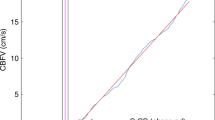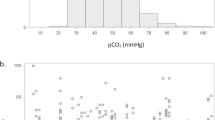Abstract
Objective:
To quantify cerebrovascular autoregulation as a function of gestational age (GA) and across the phases of the cardiac cycle.
Study design:
The present study is a hypothesis-generating re-analysis of previously published data. Premature infants (n=179) with a GA range of 23 to 33 weeks were monitored with umbilical artery catheters and transcranial Doppler insonation of the middle cerebral artery for 1-h sessions over the first week of life. Autoregulation was quantified by three methods, as a moving correlation coefficient between: (1) systolic arterial blood pressure (ABP) and systolic cerebral blood flow (CBF) velocity (Sx); (2) mean ABP and mean CBF velocity (Mx); and (3) diastolic ABP and diastolic CBF velocity (Dx). Comparisons of individual and cohort cerebrovascular pressure autoregulation were made across GA for each aspect of the cardiac cycle.
Results:
Systolic, mean and diastolic ABP increased with GA (r=0.3, 0.4 and 0.4; P<0.0001). Systolic CBF velocity was pressure-passive in infants with the lowest GA, and Sx decreased with advancing GA (r=−0.3; P<0.001), indicating increased capacity for cerebral autoregulation during systole during development. By contrast, Dx was elevated, indicating dysautoregulation, in all subjects and showed minimal change with advancing GA (r=−0.06; P=0.05). Multivariate analysis confirmed that both GA (P<0.001) and ‘effective cerebral perfusion pressure’ (ABP minus critical closing pressure (CrCP); P<0.01) were associated with Sx.
Conclusion:
Premature infants have low and usually pressure-passive diastolic CBF velocity. By contrast, the regulation of systolic CBF velocity by pressure autoregulation developed in this cohort between 23 and 33 weeks GA. Elevated effective cerebral perfusion pressure derived from the CrCP was associated with dysautoregulation.
This is a preview of subscription content, access via your institution
Access options
Subscribe to this journal
Receive 12 print issues and online access
$259.00 per year
only $21.58 per issue
Buy this article
- Purchase on Springer Link
- Instant access to full article PDF
Prices may be subject to local taxes which are calculated during checkout



Similar content being viewed by others
References
Seri I (ed). Circulatory Support of the Sick Newborn Iinfant. WB Saunders Co.: London, UK, 2001.
Sarkar S, Bhagat I, Dechert R, Schumacher RE, Donn SM . Severe intraventricular hemorrhage in preterm infants: comparison of risk factors and short-term neonatal morbidities between grade 3 and grade 4 intraventricular hemorrhage. Amer J Perinatol 2009; 26 (06): 419–424.
Kaiser JR, Gauss CH, Williams DK . The effects of hypercapnia on cerebral autoregulation in ventilated very low birth weight infants. Pediatr Res 2005; 58 (5): 931–935.
Al-Aweel I, Pursley D, Rubin L, Sharh B, Weisberger S, Richardson D . Variations in prevalence of hypotension, hypertension, and vasopressor use in NICUs. J Perinatol 2001; 21 (5): 272–278.
Laughon M, Bose C, Allred E, O'Shea TM, Marter LJV, Bednarek F et al. Factors associated with treatment for hypotension in extremely low gestational age newborns during the first postnatal week. Pediatrics 2007; 119 (2): 273–280.
Perlman J, Volpe JJ . Intraventricular hemorrhage in extremely small premature infants. Am J Dis Child 1986; 140 (11): 1122–1124.
Volpe JJ . Brain injury in the premature infant. Neuropathology, clinical aspects, pathogenesis, and prevention. Clin Perinatol 1997; 24 (3): 567–587.
Del Toro J, Louis PT, Goddard-Finegold J . Cerebrovascular regulation and neonatal brain injury. Pediatr Neurol 1991; 7 (1): 3–12.
Ment LR, Stewart WB, Duncan CC, Pitt BR, Rescigno A, Cole J . Beagle puppy model of perinatal cerebral infarction. J Neurosurg 1985; 63 (3): 441–447.
Ment LR, Stewart WB, Duncan CC, Pitt BR . Beagle puppy model of perinatal cerebral insults. J Neurosurg 1986; 65 (6): 847–850.
Lynch JK, Nelson KB . Epidemiology of perinatal stroke. Curr Opin Pediatr 2001; 13 (6): 499–505.
Lee JK, Kibler KK, Benni PB, Easley RB, Czosnyka M, Smielewski P et al. Cerebrovascular reactivity measured by near-infrared spectroscopy. Stroke 2009; 40 (5): 1820–1826.
Aries MJH, Czosnyka M, Budohoski KP, Steiner LA, Lavinio A, Kolias AG et al. Continuous determination of optimal cerebral perfusion pressure in traumatic brain injury. Crit Care Med 2012; 40 (8): 2456–2463.
Steiner L, Czosnyka M, Piechnik S, Smielewski P, Chatfield D, Menon DK et al. Continuous monitoring of cerebrovascular pressure reactivity allows determination of optimal cerebral perfusion pressure in patients with traumatic brain injury. Crit Care Med 2002; 30 (4): 733–738.
Lightburn M, Gauss C, Williams D, Kaiser JR . Cerebral blood flow velocities in extremely low birth weight infants with hypotension and infants with normal blood pressure. J Pediatr 2009; 154 (6): 824–828.
Perlman J, Goodman S, Kreusser K, Volpe JJ . Reduction in intraventricular hemorrhage by elimination of fluctuating cerebral blood-flow velocity in preterm infants with respiratory distress syndrome. N Engl J Med 1985; 312 (21): 1353–1357.
Pryds O, Greisen G, Lou H, Friis-Hansen B . Heterogeneity of cerebral vasoreactivity in preterm infants supported by mechanical ventilation. Pediatrics 1989; 115 (4): 638–645.
Tsuji M, Saul JP, du Plessis A, Eichenwald E, Sobh J, Crocker R et al. Cerebral intravascular oxygenation correlates with mean arterial pressure in critically ill premature infants. Pediatrics 2000; 106 (4): 625–632.
Bassan H, Gauvreau K, Newburger J, Tsuji M, Limperopoulos C, Soul JS et al. Identification of pressure passive cerebral perfusion and its mediators after infant cardiac surgery. Pediatr Res 2005; 57 (1): 35–41.
Gilmore MM, Stone BS, Shepard JA, Czosnyka M, Easley RB, Brady KM . Relationship between cerebrovascular dysautoregulation and arterial blood pressure in the premature infant. J Perinatol 2011; 31 (11): 722–729.
Soul J, Hammer P, Tsuji M, Saul J, Bassan H, Limperopoulos C et al. Fluctuating pressure-passivity is common in the cerebral circulation of sick premature infants. Pediatr Res 2007; 61 (4): 467–473.
Wong F, Leung T, Austin T, Wilkinson M, Meek J, Wyatt J et al. Impaired autoregulation in preterm infants identified by using spatially resolved spectroscopy. Pediatrics 2008; 121 (3): e604–e611.
Szymonowicz W, Walker A, Yu V, Stewart M, Cannata J, Cussen L . Regional cerebral blood flow after hemorrhagic hypotension in the preterm, near-term, and newborn lamb. Pediatr Res 1990; 28 (4): 361–366.
Helou S, Koehler R, Gleason C, Jones M Jr, Traystman R . Cerebrovascular autoregulation during fetal development in sheep. Am J Physiol 1994; 266: H1069–H1074.
Kaiser JR, Gauss CH, Williams DK . Surfactant administration acutely affects cerebral and systemic hemodynamics and gas exchange in very-low-birth-weight infants. J Pediatr 2004; 144 (6): 809–814.
Kaiser J, Gauss C, Williams D . Tracheal suctioning is associated with prolonged disturbances of cerebral hemodynamics in very low birth weight infants. J Perinatol 2007; 28 (1): 34–41.
Kaiser J, Gauss C, Williams D . The effects of closed tracheal suctioning plus volume guarantee on cerebral hemodynamics. J Perinatol 2011; 31 (10): 671–676.
Varsos GV, de Riva N, Smielewski P, Pickard J, Brady K, Reinhard M et al. Critical closing pressure during intracranial pressure plateau waves. Neurocrit Care 2013; 18 (3): 341–348.
Nelson RJ, Czosnyka M, Pickard JD, Maksymowicz W, Perry S, Lovick AHJ . Experimental aspects of cerebrospinal hemodynamics: the relationship between blood flow velocity waveform and cerebral autoregulation. Neurosurgery 1992; 31 (4): 705–710.
Czosnyka M, Smielewski P, Kirkpatrick P, Menon DK, Pickard JD . Monitoring of cerebral autoregulation in head-injured patients. Stroke 1996; 27 (10): 1829–1834.
Fraser CD III, Brady K, Rhee CJ, Easley RB, Kibler KK, Smielewski P et al. The frequency response of cerebral autoregulation. J Appl Physiol 2013; 115 (1): 52–56.
Lundberg N, Troupp H, Lorin H . Continuous recording of the ventricular-fluid pressure in patients with severe acute traumatic brain injury. A preliminary report. J Neurosurg 1965; 22 (6): 581–590.
Steinmeier R, Bauhuf C, Hubner U, Bauer RD, Fahlbusch R, Laumer R et al. Slow rhythmic oscillations of blood pressure, intracranial pressure, microcirculation, and cerebral oxygenation: dynamic interrelation and time course in humans. Stroke 1996; 27 (12): 2236–2243.
Czosnyka M, Smielewski P, Lavinio A, Pickard JD, Panerai R . An assessment of dynamic autoregulation from spontaneous fluctuations of cerebral blood flow velocity: a comparison of two models, index of autoregulation and mean flow index. Anesth Analg 2008; 106 (1): 234–239.
Nichol J, Girling F, Jerrard W, Claxton E, Burton A . Fundamental instability of the small blood vessels and critical closing pressures in vascular beds. Am J Physiol 1951; 164 (2): 330–344.
Panerai R . The critical closing pressure of the cerebral circulation. Med Eng Phys 2003; 25 (8): 621–632.
Dewey R, Pieper H, Hunt W . Experimental cerebral hemodynamics. Vasomotor tone, critical closing pressure, and vascular bed resistance. J Neurosurg. 1974; 41 (5): 597–606.
Michel E, Zernikow B, von Twickel J, Hillebrand S, Jorch G . Critical closing pressure in preterm neonates: towards comprehensive model of cerebral autoregulation. Neurol Res. 1995; 17 (2): 149–155.
Panerai R, Kelsall A, Rennie J, Evans D . Estimation of critical closing pressure in the cerebral circulation of newborns. Neuropediatrics 1995; 26 (3): 168–173.
Varsos GV, Richards H, Kasprowicz M, Budohoski KP, Brady KM, Reinhard M et al. Critical closing pressure determined with a model of cerebrovascular impedance. J Cereb Blood Flow Metab 2013; 33 (2): 235–243.
Zeger SL, Liang KY . Longitudinal data analysis for discrete and continuous outcomes. Biometrics 1986; 42 (1): 121–130.
Ratcliffe S, Shults J . GEEQBOX: a Matlab toolbox for generalized estimating equations and quasi-least squares. J Stat Softw 2008; 25 (14): 1–14.
Spinazzola R, Harper R, de Soler M, Lesser M . Blood pressure values in 500- to 750-gram birthweight infants in the first week of life. J Perinatol 1991; 11 (2): 147–151.
Lee J, Rajadurai VS, Tan KW . Blood pressure standards for very low birthweight infants during the first day of life. Arch Dis Child Fetal Neonatal 1999; 81 (3): F168–F170.
Cunningham S, Symon A, Elton R, Zhu C, McIntosh N . Intra-arterial blood pressure reference ranges, death and morbidity in very low birthweight infants during the first seven days of life. Early Hum Dev 1999; 56 (2-3): 151–165.
Acknowledgements
Dr Kaiser was supported by the National Institutes of Health (1K23NS43185, RR20146 and 1R01NS060674) and the University of Arkansas for Medical Sciences Translational Research Institute (1UL1RR029884). The technical assistance of Natalie C Sikes and Melanie J Mason and the support of the University of Arkansas for Medical Sciences neonatologists, NICU nurses, respiratory therapists and ultrasound technicians are gratefully appreciated.
AUTHOR CONTRIBUTIONS
Each author listed on this manuscript has seen and approved the submission of this version of the manuscripts and takes full responsibility for the manuscript. CJR conceptualized the reanalysis of the primary data, performed the data analysis, drafted the initial manuscript and reviewed and revised the manuscript. KK, RBE, DBA, MC, PS and CGR reviewed and revised the manuscript. GVV performed data analysis and reviewed and revised the manuscript. KMB performed data analysis, reviewed and revised the manuscript. JRK conceptualized and designed the initial study, collected the primary data, performed the data analysis and reviewed and revised the manuscript.
Author information
Authors and Affiliations
Corresponding author
Ethics declarations
Competing interests
The authors declare no conflict of intrest.
Rights and permissions
About this article
Cite this article
Rhee, C., Fraser III, C., Kibler, K. et al. The ontogeny of cerebrovascular pressure autoregulation in premature infants. J Perinatol 34, 926–931 (2014). https://doi.org/10.1038/jp.2014.122
Received:
Revised:
Accepted:
Published:
Issue Date:
DOI: https://doi.org/10.1038/jp.2014.122
This article is cited by
-
Diffuse correlation spectroscopy blood flow monitoring for intraventricular hemorrhage vulnerability in extremely low gestational age newborns
Scientific Reports (2022)
-
The impact of initial hematocrit values after birth on peri-/intraventricular hemorrhage in extremely low birth weight neonates
Child's Nervous System (2022)
-
Neonatal NIRS monitoring: recommendations for data capture and review of analytics
Journal of Perinatology (2021)
-
Assessing key clinical parameters before and after intraventricular hemorrhage in very preterm infants
European Journal of Pediatrics (2020)
-
Observed and calculated cerebral critical closing pressure are highly correlated in preterm infants
Pediatric Research (2019)



